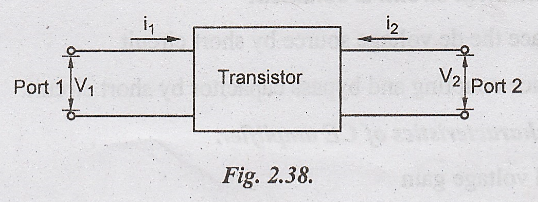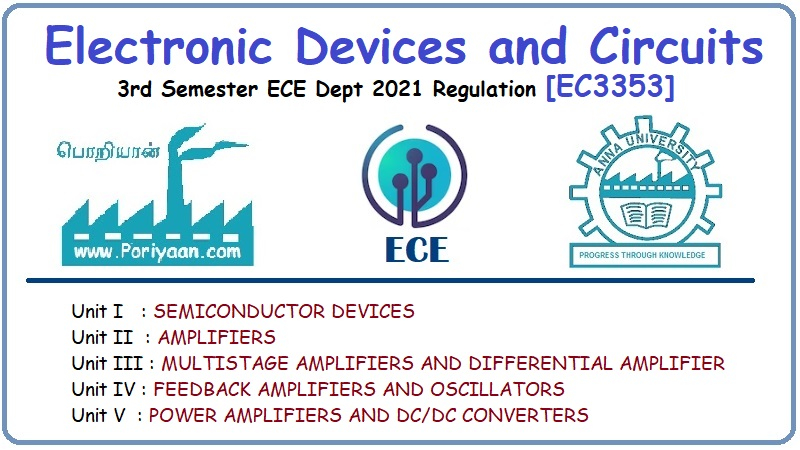Electronic Devices and Circuits: Unit II: Amplifiers
Important Two Marks Questions with Answers on Amplifiers
Anna university important two marks questions with answers
TWO MARKS QUESTION AND ANSWERS
1.
Define an Amplifier.
An
amplifier is defined as the device which increases the magnitude of the input
signal and produces a larger electrical output.
2.
What do you mean by linear amplifier?
If
the output signal is directly proportional to the corresponding input signal,
then the amplifier is called linear amplifier.
3.
What is meant by non-linear amplifier?
If
the output signal is not directly proportional to the input signal, then the
amplifier is called non-linear amplifier.
4.
How amplifiers are classified based on configuration?
i.
Common Emitter (CE) amplifier
ii.
Common Base (CB) amplifier
iii.
Common Collector (CC) amplifier
5.
Draw the transistor two port model.

6.
Define small signal amplifier.
The
amplifier which operates on small signal is called small signal amplifier small
signal indicates that the input signal is very small in the range of few mV.
7.
What do you mean by hybrid parameter?
The
input current i1 and the output voltage V2 are taken as
independent variables. The input voltage V1 and the output current i2
are expressed in terms of i1 and V2. The units of these
four parameters are completely different from each other, these parameters are
called hybrid parameters.
8.
What are the factors affecting h-parameters?
i.
Transistor type
ii.
Transistor configuration
iii.
Operating point
iv.
Frequency
v.
Temperature
9.
What are the advantages of h-parameter?
i.
Easy to measure from static characteristics of transistor
ii.
Simple conversion from one configuration to other
iii.
Can be used upto radio frequencies.
iv.
Convenient for circuit analysis and design.
10.
List the steps involved in small signal analysis of amplifier.
i.
Draw the ac equivalent circuit of the amplifier
ii.
Draw the hybrid equivalent circuit
iii.
Calculate the input impedance, output impedance, current gain and voltage gain.
11.
How ac equivalent circuit is obtained?
i.
Replace the dc voltage source by short circuit
ii.
Replace coupling and bypass capacitor by short circuit.
12.
Write the characteristics of CE amplifier.
i. Good voltage gain
ii.
Output voltage is 180° out of phase with input
iii.
Good current gain and power gain
13.
List the characteristics of CB amplifier.
i.
Provides voltage gain and power gain
ii.
High output impedance and very low input impedance
iii.
No current gain
14.
List the characteristics of CC amplifier.
i.
Provides current gain and power gain
ii.
High input impedance and very low output impedance 3. No voltage gain
15.
Why common drain amplifier is called source follower?
The
input signal is applied to the gate terminal and the output terminal is taken
from the source terminal. The source exactly follows the input signal. Hence it
is called as source follower.
16.
Write the properties of common source amplifier.
i.
High input and output impedance
ii.
Relatively high small-signal voltage gain.
iii.
Very high small-signal current gain.
17.
List the properties of common drain amplifier.
i.
Non inverting amplifier
ii.
Very large input impedance
iii.
Small output impedance
iv.
Voltage gain AV < 1
v.
Large small-signal current gain
18.
What is the need for multistage amplifier?
i.
When input or output impedance is not of correct magnitude for the intended
application.
ii. When amplification of simple stage amplifier is not sufficient.
19.
Define voltage gain of the cascaded amplifier.
The
voltage gain of the cascaded amplifier is defined as the product of the
individual voltage gain of each stage.

20.
How voltage gain is expressed in terms of current gain?

21.
What are the high frequency effects?
When
the frequency is increased sufficiently, the internal capacitances start
becoming significant and start affecting the voltage gain. The coupling and
bypass capacitors offer a very low reactance and hence they can be treated as
short circuits.
22.
What are the causes for upper cut-off frequencies in BJT.
Main
causes for upper cut-off frequencies in BJT are that the amplifier gain reduces
at low and high frequencies. A range of frequencies over which the voltage
gain, is close to or equal to AV is obtained.
23.
Compare the gain at low frequency and high frequency region.
The
amplifier gain in low frequency region decreases due to coupling and bypass
capacitors.
In
high frequency region, the output voltage and gain will decrease due to
transistor internal capacitance and stray capacitance.
REVIEW QUESTIONS
1.
Discuss the effect of coupling capacitor and bypass capacitor on low frequency
response of BJT amplifiers.
2.
Draw the high frequency equivalent circuit of a transistor and explain.
3. Derive the expression for 3-dB cut-off frequency of emitter follower using its equivalent circuit.
4.
Explain in detail the operation of CE amplifier and its high frequency
equivalent circuit.
5.
Why is CC amplifier called source follower? Explain.
6.
Draw the equivalent circuit of common-source amplifier at high frequencies and
derive expressions for voltage gain, input and output impedance.
7.
What are the parameters that will influence the frequency response of FET
amplifiers? Explain.
8.
Draw the high frequency model of FET.
9.
How are amplifiers classified? Explain.
10.
What do you mean by hybrid parameters? Explain.
11.
Explain the steps involved in small signal analysis of transistors..
12.
Explain the analysis of CE amplifier with emitter resistor.
13.
Explain in detail the construction operation and analysis of CB amplifier.
14.
Draw the hybrid equivalent circuit of common drain amplifier and derive its
parameters.
15.
Explain in detail the small signal analysis of common gate JFET amplifier.
16.
Discuss the steps involved in small signal analysis of MOSFET.
17.
Derive the input impedance, output impedance, voltage gain and current gain of
common source MOSFET amplifier.
18.
Explain the operation of common drain MOSFET amplifier and derive its
parameters.
19.
Explain the gain and frequency response of BJT amplifier.
20.
Discuss the frequency response of FET amplifier.
21.
List the need for multistage amplifier. Derive its voltage gain.
Electronic Devices and Circuits: Unit II: Amplifiers : Tag: : - Important Two Marks Questions with Answers on Amplifiers
Related Topics
Related Subjects
Electronic Devices and Circuits
EC3353 - EDC - 3rd Semester - ECE Dept - 2021 Regulation | 3rd Semester ECE Dept 2021 Regulation
